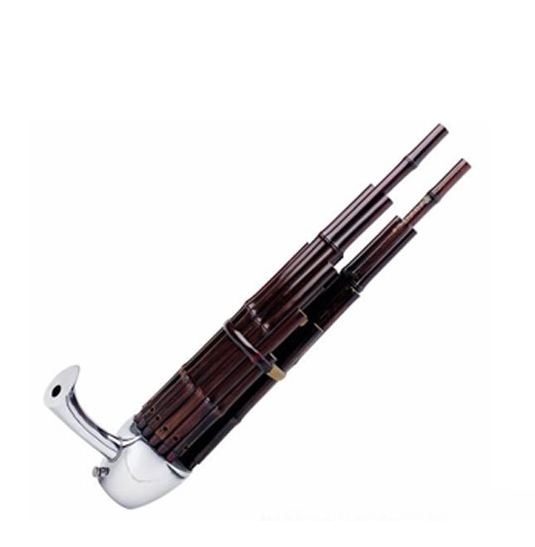Sheng
Woodwinds
Asia
Between 1001 and 1900 AD
Video
The sheng is a traditional Chinese musical instrument classified as a free reed aerophone. It is a mouth-blown polyphonic free reed instrument that consists of multiple vertical pipes. It is often referred to as the “Chinese mouth organ.” The sheng typically contains 17 to 36 pipes, each fitted with a free brass reed at the base.
The pipes are arranged in a bundle and seated on a small wind chamber, allowing for the production of chords and harmonies. Players can produce sound by blowing air into the instrument while covering and uncovering finger holes, enabling them to create different pitches. The sheng can be played by both exhaling and inhaling. The sheng, a traditional Chinese musical instrument, employs several unique playing techniques that enhance its expressive capabilities. Here are the key techniques used in playing the sheng:
Unique Playing Techniques
- Players control the airflow by blowing into the mouthpiece, affecting the sound’s pitch and volume. Proper breath control is essential for achieving a clear and resonant tone.
- The sheng has multiple finger holes that players cover and uncover to produce different pitches. Various finger combinations allow for a range of notes, including single notes and chords.
- Tonguing techniques, such as single-tonguing, double-tonguing, and triple-tonguing, are employed to articulate notes clearly. This technique can mimic percussive sounds, adding rhythmic elements to the music.
- This advanced technique allows players to inhale through the nose while blowing air out through the mouth, enabling continuous sound production without breaks. This is particularly useful for sustaining long phrases.
- Players often use techniques like bending notes, vibrato, and glissando to add expressiveness and ornamentation to their playing. These embellishments enhance the melodic quality of the music.
- Different articulation styles, such as staccato (short, detached notes) and legato (smooth, connected notes), can be achieved through varying finger placements and breath control.
- Understanding musical phrases and dynamics helps players shape their interpretations, allowing them to convey emotions effectively through their performance.
- The sheng’s design allows it to play multiple notes simultaneously, making it capable of producing harmonies and chords, which is a unique feature among traditional wind instruments.
Historical Origins
Early References: The sheng first appears in historical records around 551 BC during the Zhou Dynasty (1046–256 BC), but evidence suggests that similar free reed instruments existed as far back as 1100 BC. Some sources indicate that prototypes of the sheng were present even earlier, around 3000 years ago.
Cultural Significance: The sheng has been an integral part of Chinese music throughout its history, used in both court music and folk traditions. It is known for its ability to produce chords and harmonies, making it unique among wind instruments.
Development Through Dynasties: The sheng evolved significantly during various Chinese dynasties, particularly during the Han Dynasty (206 BC–220 AD), when it became more refined in construction and widely used in orchestras.
Influence on Other Instruments: The sheng has influenced the development of other free reed instruments throughout Asia, such as the Japanese shō and the Korean saenghwang. Its design also inspired European free reed instruments like the accordion and harmonica after it was introduced to Europe in the late 18th century.
Modern Context
The sheng remains popular in both traditional and contemporary Chinese music. It is often played in orchestras and is featured in various genres, including folk music, where it accompanies other instruments like the dizi (bamboo flute) and suona (double-reed horn). Modern variants of the sheng include different numbers of pipes (ranging from 17 to 36) and may feature keys for easier playability. These adaptations have allowed the sheng to maintain its relevance in modern musical contexts.
Variants
There are two main categories of sheng:
Traditional Sheng: Smaller and handheld, requiring finger manipulation to cover holes.
Reformed Sheng: Larger, often played resting on the lap or on a stand, featuring keys for easier note production.
The sheng is a versatile and ancient Chinese woodwind instrument known for its ability to produce chords and harmonies. Its unique construction and historical significance make it an essential part of Chinese musical heritage.
FAQ
What are the main components of a traditional sheng?
A traditional sheng consists of three main components. A tube or opening through which the player blows air into the instrument, A hollow, often gourd-shaped or wooden chamber that distributes air to the pipes, and Multiple vertical bamboo or metal pipes, each with a free reed and a finger hole. The pipes are arranged in a circular or fan-shaped pattern, and only the pipes with open holes produce sound when air flows through them.
What are the unique playing techniques used on the sheng?
Unique playing techniques used on the sheng include Polyphonic playing, Vibrato, Pitch bending, Tonguing and staccato, and Circular breathing.
How does the sheng's construction affect its playing techniques?
The sheng's construction profoundly influences its playing techniques by combining functionality and versatility. The use of free reeds in each pipe allows for precise pitch control, enabling techniques such as vibrato, pitch bending, and dynamic variation. Its circular or fan-shaped pipe arrangement provides easy access to multiple notes, facilitating polyphonic playing and quick transitions. The wind chamber ensures even air distribution, making techniques like circular breathing and sustained tones more manageable.
 Links
Links
References
Other Instrument
Categories


















